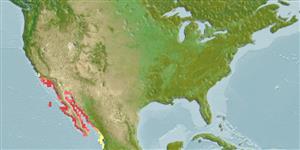Environment: milieu / climate zone / depth range / distribution range
Écologie
marin benthopélagique; profondeur 0 - 8 m (Ref. 9310). Subtropical; 37°N - 20°N, 123°W - 105°W
Eastern Central Pacific: Monterey Bay in California, USA to Gulf of California.
Taille / Poids / Âge
Maturity: Lm ? range ? - ? cm
Max length : 45.0 cm TL mâle / non sexé; (Ref. 9310)
Description synthétique
Clés d'identification | Morphologie | Morphométrie
Épines dorsales (Total) : 11; Rayons mous dorsaux (Total) : 10 - 11; Épines anales: 3; Rayons mous anaux: 10; Vertèbres: 25. This species is distinguished by the following characters: interorbital region scaleless; mouth terminal; teeth incisiform; 5-9 vertical dark bands on body; D XI,10-11 rays; A III,10; gill rakers 4-5 + 11-12; 49-55 lateral line scales, of which 45-49 have pores; longitudinal row 43-49 scales; cheek scales 5-6; postorbital scales 7-8; precaudal vertebrae 10, caudal vertebrae 15; pterygiophores, 19-20 on dorsal, 11 on anal (Ref. 95491).
Inhabit shallow inshore areas to 8 m depth (Ref. 9310); coastal rocky reefs and reef flats with algal growth (Ref. 95491). Exclusively herbivorous (Ref. 95491). Encountered frequently in schools near Abudefduf troschelii. Pelagic spawner (Ref. 56049). Also caught with harpoons (Ref. 9310).
Life cycle and mating behavior
Maturité | Reproduction | Frai | Œufs | Fécondité | Larves
Pelagic spawner (Ref. 56049).
Knudsen, S.W. and K.D. Clements, 2013. Revision of the fish family Kyphosidae (Teleostei: Perciformes). Zootaxa 3751(1):001-101. (Ref. 95491)
Statut dans la liste rouge de l'IUCN (Ref. 130435: Version 2024-1)
Menace pour l'homme
Harmless
Utilisations par l'homme
Outils
Articles particuliers
Télécharger en XML
Sources Internet
Estimates based on models
Preferred temperature (Ref.
123201): 18.2 - 26.9, mean 23.2 °C (based on 114 cells).
Phylogenetic diversity index (Ref.
82804): PD
50 = 0.5000 [Uniqueness, from 0.5 = low to 2.0 = high].
Bayesian length-weight: a=0.01660 (0.00840 - 0.03281), b=3.05 (2.87 - 3.23), in cm total length, based on LWR estimates for this species & (Sub)family-body (Ref.
93245).
Niveau trophique (Ref.
69278): 2.0 ±0.0 se; based on diet studies.
Résilience (Ref.
120179): Milieu, temps minimum de doublement de population : 1,4 à 4,4 années (Preliminary K or Fecundity.).
Fishing Vulnerability (Ref.
59153): Low to moderate vulnerability (35 of 100).
Nutrients (Ref.
124155): Calcium = 70.1 [34.6, 122.5] mg/100g; Iron = 0.874 [0.485, 1.586] mg/100g; Protein = 17.6 [16.4, 18.8] %; Omega3 = 0.172 [0.086, 0.344] g/100g; Selenium = 21.1 [8.3, 49.6] μg/100g; VitaminA = 10.5 [2.2, 44.7] μg/100g; Zinc = 1.04 [0.71, 1.61] mg/100g (wet weight);
